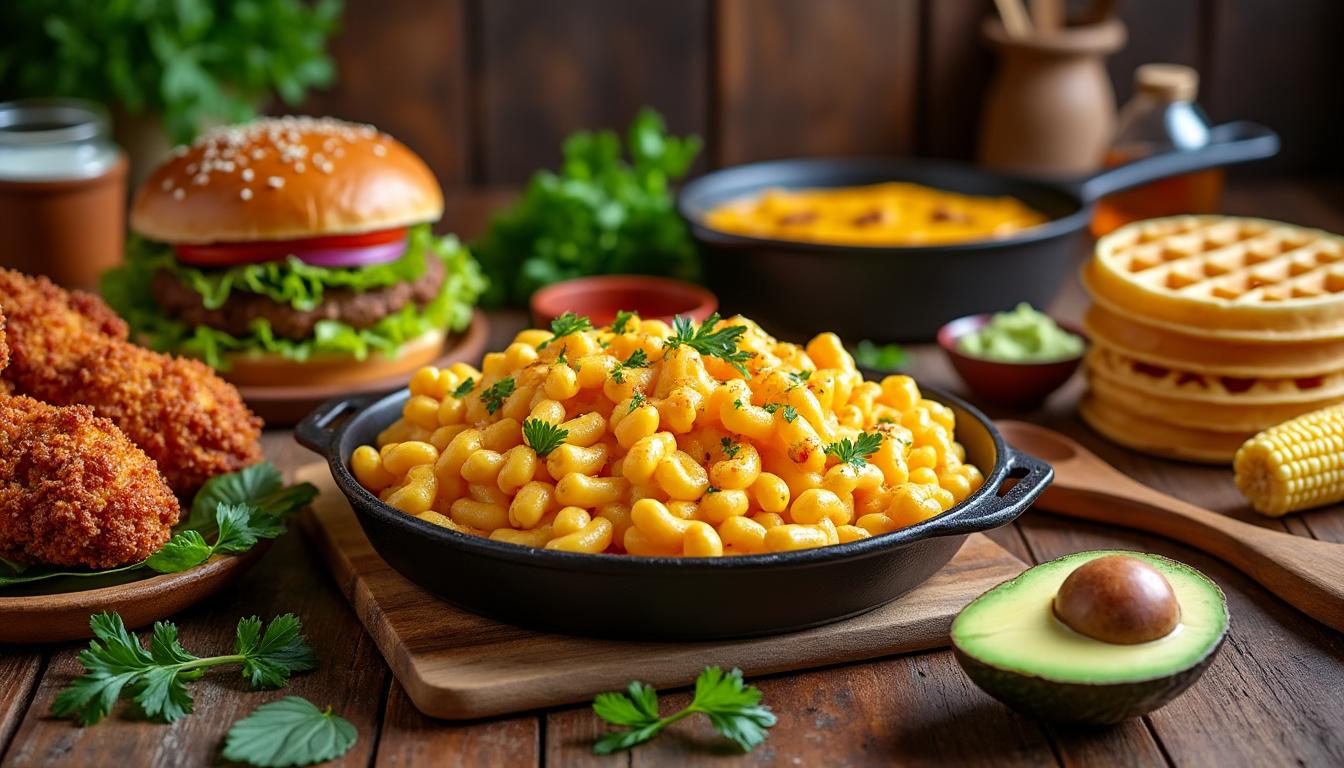The panorama of American cuisine throughout the last hundred years is a fertile ground of innovation, resilience, and cultural fusion. Recipes that at first glance might seem simple, from Caesar Salad to the Toll House Chocolate Chip Cookie, have been emblematic agents of transformation, challenging traditions and molding new culinary habits nationwide. These recipes, developed across decades, do not just satisfy hunger; they narrate tales of immigration, technological advances, and sociopolitical shifts that shaped the American palate.
Exploring this century-long culinary journey invites professionals, hobbyists, and cultural historians alike to grasp how the act of cooking and sharing food intertwines with identity and adaptation. The following sections delve into important recipes and movements that have revolutionized American cuisine, focusing on the ingredients, techniques, and cultural contexts that redefined home cooking and commercial food industries.
Innovative Classic Recipes That Sparked Culinary Shifts in American Kitchens
Throughout the twentieth century, a handful of recipes emerged as true catalysts in American home kitchens, driven by ingenuity, accessibility, and changes in consumer culture. Some of these were born from circumstance—like Caesar Salad, crafted during the Prohibition era when creativity in the kitchen was necessary. Others arose from corporate food development, such as the famous Toll House Chocolate Chip Cookie, which originated from Ruth Wakefield’s clever adaptation of Nestlé chocolate bars in 1938.
Notable recipes that revolutionized kitchen practices include:
- Caesar Salad (1924): Invented by Caesar Cardini, this salad combined minimal ingredients to deliver maximum flavor, quickly capturing attention nationwide and illustrating food’s power as a theatrical and resourceful craft.
- Toll House Chocolate Chip Cookie (1938): This cookie introduced small chocolate pieces rather than melted chocolate, revolutionizing baking and commercializing home baking, influencing brands like Betty Crocker and Pamela’s Products.
- Green Bean Casserole (1955): Developed by Dorcas Reilly at Campbell’s Soup, this recipe epitomized midcentury convenience food culture, merging common packaged goods into a household staple still revered during American holidays.
- Boeuf Bourguignon (1961): Popularized by Julia Child, this French classic taught Americans that mastering global cuisine was within reach and helped broaden tastes beyond traditional American dishes.
- Stir-Frying Techniques (1945): Introduced by Buwei Yang Chao and her family, this Chinese cooking method emphasized speed, flavor, and the adaptation of immigrant culinary traditions into mainstream American cooking.
These recipes not only modified food preparation approaches but also reshaped consumer expectations, with influence extending to institutions like the Culinary Institute of America and retail giants such as Williams Sonoma and Blue Apron, who have further disseminated these culinary innovations.
| Recipe | Year Introduced | Significance | Influential Figures/Companies |
|---|---|---|---|
| Caesar Salad | 1924 | Created a new salad dressing standard, highlighting theatrical preparation and economy | Caesar Cardini |
| Toll House Chocolate Chip Cookie | 1938 | Invented the chocolate chip cookie, influencing baking culture and commercial products | Ruth Wakefield, Nestlé, Betty Crocker |
| Green Bean Casserole | 1955 | Symbolized convenience cooking using canned goods, shifting home meal preparation | Dorcas Reilly, Campbell’s Soup Company |
| Boeuf Bourguignon | 1961 | Popularized French cooking techniques and gourmet ambitions among Americans | Julia Child, Culinary Institute of America |
| Stir-Frying Technique | 1945 | Introduced fast, flavorful cooking methods, integrating Chinese culinary practices | Buwei Yang Chao |
The Corporate Food Revolution Impacting American Home Cooking and Recipe Development
The mid-20th century witnessed a profound intersection of food industrialization and home cooking, where corporations leveraged innovative marketing and product research to influence recipes that became central to American identity. Companies like Campbell’s Soup and Lipton used convenience and consistent results to appeal to postwar consumers, while Betty Crocker emerged as a household name synonymous with culinary trust and creativity.
Recipes such as the Green Bean Casserole or Lipton Onion Soup Meat Brisket underscored a cultural shift – cooking was no longer solely about tradition or artisan skills but also about efficiency and ease, aligning with societal changes as more women entered the workforce.
- Key corporate contributions included:
- Packaging and standardizing recipes, ensuring their reach to millions of homes.
- Incorporating food science and R&D to improve flavor and convenience.
- Collaborating with culinary institutions and personalities, reinforcing recipe credibility.
- Supporting consumer education through printed recipes on packaging and media.
As an example, Campbell’s Green Bean Casserole became a cultural staple because of its simple ingredients and the company’s strategic distribution including featuring on soup cans and advertising campaigns during holiday seasons. Society was encouraged to embrace convenience cooking without sacrificing taste, a controversial evolution debated by culinary purists but embraced widely.
| Company | Influential Recipes | Marketing Strategies | Impact on Home Cooking |
|---|---|---|---|
| Campbell’s Soup Company | Green Bean Casserole | Printed recipes on cans, holiday advertising | Normalized use of canned ingredients, convenience |
| Lipton Inc. | Homestyle Beef Brisket | Recipe cards, soup mix innovation | Introduced seasoning blends for easy flavor enhancement |
| Betty Crocker (General Mills) | Wide array of baking and cooking recipes | Cookbooks, television shows, brand trust-building | Empowered home bakers with approachable, tested recipes |
| Pamela’s Products | Gluten-free baking mixes | Health-optimized recipes targeting dietary needs | Expanded inclusivity in American baking culture |
Transformative Influence of Iconic Food Personalities and Media on American Culinary Trends
The dissemination and popularization of groundbreaking recipes were significantly boosted by the roles of chefs, television personalities, food writers, and retailers throughout the decades. Pioneers like Julia Child opened the door to sophisticated cooking for the American household, while contemporary figures on the Food Network and culinary institutions further shaped tastes and accessibility.
Martha Stewart transformed domestic cooking into an aspirational lifestyle brand, merging elegant presentation with practical guidance. Meanwhile, retailers like Dean & DeLuca and Williams Sonoma introduced Americans to upscale ingredients and tools, supporting home cooks in executing complex recipes with greater ease.
- Key individuals and entities revolutionizing cuisine:
- Julia Child: Brought French gastronomy to the masses with approachable techniques.
- Martha Stewart: Pioneered lifestyle cooking, blending culinary arts with home aesthetics.
- Nadia G: Showcased vibrant cooking styles on Food Network, inspiring diverse audiences.
- Dean & DeLuca and Williams Sonoma: Curated gourmet ingredients and culinary hardware.
- Culinary Institute of America: Trained generations of chefs, influencing recipe standards.
These figures and institutions created a feedback loop whereby broad public enthusiasm drove demand for cookbooks, culinary classes, and premium products, which, in turn, fueled further innovation and recipe circulation. Their legacies continue to underpin many cooking trends prevalent today.
Global Flavors and Fusion: The Rise of Multicultural Influences in American Recipes
American cuisine is fundamentally a product of cultural intermingling. The past century’s recipes incorporated techniques and ingredients from Asian, Mexican, Middle Eastern, and Indian cuisines, reflecting the country’s evolving demographics and international openness. Recipes such as stir-fry, garam masala blends, enchiladas, and baklawa highlight how immigrant communities influenced mainstream American cooking.
Food writers and chefs like Madhur Jaffrey and Rose Previte became ambassadors of authentic and adapted ethnic recipes, facilitating understanding and acceptance through accessible cookbooks and restaurants. Fusion recipes, like Eric Kim’s Gochujang Caramel Cookies, symbolize contemporary trends of blending traditional elements with modern creativity to generate novel flavors.
- Examples of multicultural recipe incorporation:
- Chinese Stir-Fry techniques introduced in American homes post-World War II.
- Traditional Mexican enchiladas adapted thoughtfully for American kitchens.
- Indian garam masala blends popularized by cookbook authors introducing whole spices.
- Middle Eastern baklawa preserved and modernized via community cookbooks.
- Contemporary Korean-American desserts combining cultural spice with classic American cookies.
This evolution is not without dialogue about authenticity and adaptation, illustrating the dynamic tension between preservation and innovation in contemporary American food culture.
Digital Era and Social Media: Contemporary Recipe Revolution and Accessibility
In recent decades, the empowerment of home cooks through the digital revolution has further transformed recipe sharing and culinary trends. Platforms such as blogs, YouTube, and social media channels have enabled unprecedented reach and immediacy. Recipes like Logan’s Cucumbers, viral on TikTok, illustrate how simple yet innovative ideas can create national food phenomena practically overnight.
The internet erased traditional barriers between professional chefs and home cooks, democratizing access to knowledge once confined to culinary institutes or specialty books. This reflects a surge in DIY cooking culture, recipe adjustment, and peer-to-peer feedback driving culinary creativity and experimentation.
- Key hallmarks of the digital recipe revolution include:
- Massive crowdsourced recipe platforms like Allrecipes hosting tens of thousands of reviews.
- Cooking tutorial videos democratizing complex techniques from reverse-seared steak to no-knead bread.
- Viral recipe trends shaping mainstream grocery demands and influencing restaurant menus.
- Instant feedback loops between creators and audiences fostering rapid refinement and variation.
- Greater focus on inclusivity regarding diets through accessible online recipe sharing.
This digital ecosystem has reshaped how recipes are valued, often prioritizing user ratings and search engine optimization in recipe popularity, redefining culinary authority in 2025 and beyond.
| Recipe | Origin Era | Medium of Influence | Current Reach or Impact |
|---|---|---|---|
| Logan’s Cucumbers | 2024 | TikTok viral video | Over 15 million views, influencing cucumber sales internationally |
| No-Knead Bread | 2006 | Internet & cookbooks | Widely popular among home bakers seeking simplicity and artisan quality |
| Reverse-Seared Steak | 2007 | America’s Test Kitchen & YouTube videos | Established as a foundational cooking hack, embraced worldwide |
| Good Old-Fashioned Pancakes | 2001 | Allrecipes user-generated content | One of the most-cooked recipes globally due to SEO and positive ratings |
Frequently Asked Questions
- How have individual chefs influenced the revolution in American recipes?
Their role ranges from popularizing regional and international cuisines to demystifying complex techniques, making sophisticated cooking attainable for home cooks. - What role did corporate America have in shaping recipe trends?
Corporations like Campbell’s and Lipton played pivotal roles by creating products and marketing campaigns that enabled convenience recipes to become staples in American households. - How has globalization influenced modern American recipe development?
Recipes integrate international spices, techniques, and cultural traditions, making American cuisine a complex fusion that reflects diverse immigrant contributions. - What impact has digital media had on recipe popularity?
Platforms like TikTok and YouTube produce viral food trends, democratize access to culinary knowledge, and shape consumer demands rapidly. - Are traditional recipes still relevant in the digital age?
Yes, traditional recipes maintain cultural value but often evolve with modern ingredients, presentation, and dietary preferences influenced by current lifestyle trends.

